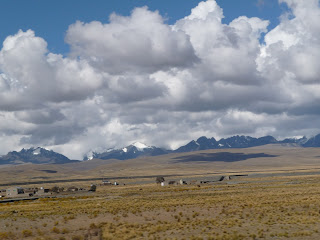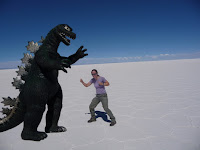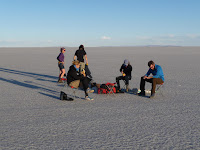We stayed in Puno for just one night which happened to be Halloween. They celebrate Halloween in style here, so every kid and several adults were dressed up. Whilst we sat in the Chinese (Chifa) restaurant, we saw lots of kids trapse in and ask the waitress for sweets, unfortunately we didn't have any to give therm.

 The next morning we caught a bus to Bolivia. The bus to the border was comfy, air-conditioned and had a toilet. However once we had gone through passport control into Bolivia, we had to squash into a tiny old minibus! Fortunately this was only for a few miles, until we reached the town of Copacabana on the shores of Lake Titicaca. This was our lunch stop and the departure point for the floating islands, which we were not visiting because Mr Greenhead went there 10 years ago. It is a strange town, which has a beuatiful location, but is a bit run down and has lots of rubbish flying around. The strangest thing is the hundred or so swan pedalos that line the beach - you could be in Skegness if it wasn't for the 30 degree heat and clear blue skies.
The next morning we caught a bus to Bolivia. The bus to the border was comfy, air-conditioned and had a toilet. However once we had gone through passport control into Bolivia, we had to squash into a tiny old minibus! Fortunately this was only for a few miles, until we reached the town of Copacabana on the shores of Lake Titicaca. This was our lunch stop and the departure point for the floating islands, which we were not visiting because Mr Greenhead went there 10 years ago. It is a strange town, which has a beuatiful location, but is a bit run down and has lots of rubbish flying around. The strangest thing is the hundred or so swan pedalos that line the beach - you could be in Skegness if it wasn't for the 30 degree heat and clear blue skies. After lunch we boarded the next bus which was to take us to La Paz, the capital of Bolivia. The bus was bigger than the minibus but just as squahsed, especailly since we were on the back row with a rather large, sweaty French lady next to us. Part way through the journey, our limited Spanish let us down again. We thought we were getting off for a toilet stop, but next thing we knew our bus was floating in a pontoon (wooden barge) across to the other side of Lake Titicaca. Fortunately there were small boats to ship us across too, which we guessed we had to get on, when the rest of the passengers on our bus did. I guess if we had stayed in the bus it would have sunk.
Finally, we arrived in the city of La Paz, which is 3650 metres above sea level and the highest capital city in the world. It is surrounded by the snow capped Andes mountains and is built on a hill, so you are forever walking up or downhill. We were dropped in the centre and were a little disorientated, but quickly found a hostal that was in our guide book (The Lonely Planet). Hostal Maya was very central, so we could explore on foot. La Paz is a busy city of contrasts, We saw lots of poor people and run down buildings, but there was also a fancy Plaza del Armas (central square), tree lined streets and fast food resturants (McDonalds, KFC etc.). The street markets and shops were full of traditional knitted goods made from Alpaca and Llama wool, so we did our Christmas shopping here and had fun barganing with the shopkeepers. Eating in La Paz was cheap, but we struggled to find good food, espcially bread which was sweet and stale. However we did manage to find a curry house owned by an English guy and an organic restaurant with fresh bread (right next to our hostal!).
We stayed in La Paz for a couple of days, then caught a night bus to Uyuni in southern Bolivia. We got on the bus to find big thick blankets in our seats, which we soon found out was due to the fact that the bus had no heating and the journey was cold. However with the help of the cozy blankets we soon dropped off. This bus didn't have any toilets, so about midnight we stopped for a toilet break. We soon found out why, the tarmac ended here and it was bumpy, gravel road the rest of the way (6 hours). So if you didn't go to the toilet, the bone shaking journey would make you need to go. As you can imagine, we barely slept the rest of the way and arrived rather tired in Uyuni.
Uyuni is the town where you leave for the Salir de Uynui (The Salt Plains). From the moment you step off the bus people are trying to sell you tours, but we resisted their charms and headed for the hostal we had booked. Arriving so early meant our room wasn't ready, but the hostal kindly let us store our bags. The desert heat (over 30 degrees) made it too hot to be carrying big rucksacks around. We decided to have breakfast first and talk to a few other travellers before we booked our tour. The boy who took our order looked about 12, but he served us a decent breakfast. Then we couldn't put it off any longer, we had to choose a tour. We trapsed round about 10 agencies and found out that all tours were identical, but the price was about 10 pounds higher if you wanted an English speaking guide. Some agencies were helpful, others rude, but what sold it for us was the silly photos one of the agencies showed us. So for no other reason than the photos made us laugh, we chose Quechua Tours. We then spent the rest of the day eating pizza for lunch (served by another 12 year old) and dinner (from Minuteman Pizza run by an American). Tasty! At 10am the next morning we met our guide Jose and our group (a German couple and a Brazilian couple). To our surprise Jose spoke perfect English and was very funny - we hadn't paid the extra so were expecting to only hear Spanish. Also the Germans and Brazilians spoke excellent English so we could understand what was going on. The Salt Plains Tour is a 3 day, 2 night trip and involves travelling by jeep driven by the Jose(Jack Sparrow as he liked to be called). The first stop was the train graveyard. This is a place where trains are brought once they no longer work and are left to rust. It is a bizarre place, but we had good fun climbing on the trains and taking photos.
At 10am the next morning we met our guide Jose and our group (a German couple and a Brazilian couple). To our surprise Jose spoke perfect English and was very funny - we hadn't paid the extra so were expecting to only hear Spanish. Also the Germans and Brazilians spoke excellent English so we could understand what was going on. The Salt Plains Tour is a 3 day, 2 night trip and involves travelling by jeep driven by the Jose(Jack Sparrow as he liked to be called). The first stop was the train graveyard. This is a place where trains are brought once they no longer work and are left to rust. It is a bizarre place, but we had good fun climbing on the trains and taking photos.Then you head for the Uyuni Salt Flats. The first stop is the salt factory at Colchani where they take the raw salt and process it so you can eat it. There were also market stalls here where you could buy all kinds of ornaments made from salt e.g. a salt ash tray. Then you go onto the salt flats themselves in the jeep. They cover 4000 square miles and are surrounded by volcanoes. At the edge of the plains is the Salt Hotel (with an island of international flags). Guests once stayed here, but it is now a musuem because it was having a bad effect on the environment.
When you are in the middle of then plains, the edge can be seen, but it is hazy. The size means you lose your sense of perspective, so you can put an object next to the camera (such as a toy dinosaur), stand about 10 metres away and it looks like you are tiny in comparison. We spent ages taking silly photos.
After a tasty lunch we headed for Incahuasi Island, otherwise known as Fish Island due to its shape. This is one of several islands in the middle of the salt plains and is covered in giant cacti. The cacti grow at a rate of 1cm a year, so the larget cactus (9metres) is 900 years old. Until recently there was a 12 metre or 1200 year old cactus, but it fell down in high winds. You can walk to a lookout point on the island and get a great view of the plains.
From here we headed to Pïa Pia Island, this was the first place in the tour that there weren't 50 other jeeps - only our company comes here. We explored the cave here and walked up to the viewpoint. Then it was back in the jeep and off to our accomodation at Chuvica. On the way Jose dropped us off to watch sunset, we weren't sure if he was coming back, but thankfully he did because the temperature drops very quickly once the sun has gone down. The tea and biscuits were very welcome at the hostal.
The hostal was made from concrete and was not on the actual plains, but the floor in the dinning room and bedrooms was salt! Also the stools we sat on to eat out delicious dinner were made from salt. There was so much food for dinner, that even Mr Greenhead couldn't finish it all. After dinner we went out to see the slat plains by night - the stars were incredible and the full moon meant it was really bright. Then at the end of a tiring day we collapsed into our salt beds (only the base, not the matress or covers) and slept very well in the silence.
On the second day we headed towards Laguna Colorada and make several stops on the way. Our first two stops weren't scheduled though! Firstly we had to find our food on the roadside after the coolbox fell off the roof whilst we were driving along and spilt everything onto the road. Amazingly some of the eggs survived unbroken! Then the jeep stopped working, but apparently it was a common problem caused by the dust. Jose fixed it in no time and we were on our way. The first proper stop was at the viewpoint for Volcan Ollague, an active volcano. You can see the smoke coming out of the top!
After the volcano we visted four lagoons - Canapa, Chiarkota, Ramaditas and Honda - all surrounded by volcanoes and mountains. We had another delicious lunch at the first lagoon and met our first flamingos. Each lagoon after that allowed us to get closer and closer to the birds, as a result we ended up taking over 200 photos of flamingos! Apparently the micro-organims they eat give them their pink colour.
Next stop was the Arbols de Piedra or Stone Tree. The clue is in the name, it is a stone that looks like a tree. There are also lots of other rocks to scramble on here, so myself and Mr Greenhead had lots of fun climbing.
Then it was the final stop for the day, at the entrance to the national park. Here there is Laguna Colorada which is a beautiful red lake with white islands (and more flamingos). The lake contains white borax and red algae. We walked up to a viewpoint and got some great photos looking over the lake.
Then it was time for some more tea and biscuits, whilst Jose managed to rustle up a delicious dinner from our slightly squashed ingredients.
The final morning we left very early (4am) for the Sol de Manana's geysers. A geyser is a hot spring in a volcanic area, that erupts and throws water or steam into the air. The ones we saw were pumping out steam that felt hot when you put your hand in it. The sun wasn't quite up yet so it was pretty chilly, but we soon forgot about that when we reached the hot springs at Aguas Terminales. We were the first group to arrive and had our own private hot springs for about 15 minutes. It was very hard to drag ourselves out, but the pancake breakfast did the trick.
After the hot springs our trip continued south towards the colourful rocks of the Desierto de Dali and Laguna Verde (Green Lake). The final destinations before we reached the Bolivia/Chile border. Sadly we said goodbye to our group here who had been alot of fun and headed fro San Pedro de Atacama.
The border crossing was the most through we had experienced in South America. They searched all our bags and checked we had no food because they don't allow any food into the country. Fortunately they didn't discover the pasta and beef jerky at the bottom of my bag, or I might have been fined! After a narrow escape we headed into the town of San Pedro de Atacama, grabbed some lunch and pretty much jumped on a bus straight away. We had had enough of the desert and wanted to see the green parks of Santiago. Thankfully Turbus can whisk you there in a mere 23 hours and for only 40 pounds each. The buses weren't quite as luxurious as Cruz del Sur in Peru and no dinner was served, but they did have films, a toilet and a dinner break at a huge service station (where we thought we lost our bus, but it was refueling).
















































No comments:
Post a Comment